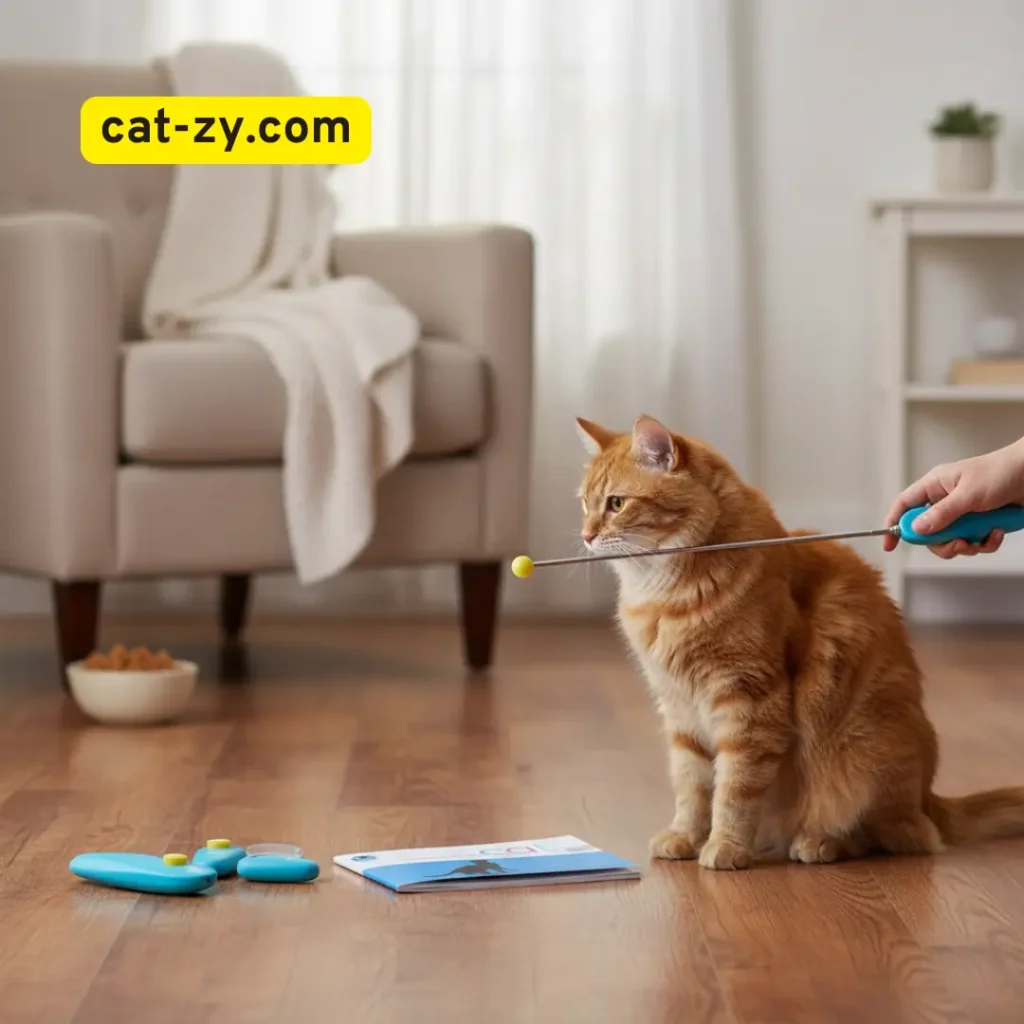Master Cat Training: 6 Proven Tips for Obedient Felines
As a feline owner exploring cat training, you know the special bond you share with your pet. However, their independent nature can make obedience seem difficult to achieve. It’s important to understand your pet’s behavior to improve your relationship.
Getting your pet to listen is more than just discipline. It’s about building trust and clear communication. With a few key techniques, you can improve your connection with your pet.
This guide will provide you with six essential tips for achieving better obedience. You’ll learn about their instincts and how to communicate better. You’ll be able to strengthen your bond and live more peacefully together.
Table of Contents
Understanding Feline Behavior Before Training

Before starting cat training, it’s key to grasp feline behavior. Cats have unique personalities and ways to communicate.
Why Cats Aren’t Like Dogs: Training Differences
Cats and dogs behave differently and need different training methods. Cats are more independent and aloof. Understanding these differences is crucial for effective cat training success.
Reading Your Cat’s Body Language
Cats mainly communicate through body language. They use postures, facial expressions, and sounds to show their feelings. By paying attention to these cues, you can understand your cat’s mood and needs better. For example, a cat with its ears back and tail twitching might be anxious or aggressive.
Training Cats at Different Life Stages

Your cat’s age significantly affects training success. Understanding age-specific needs helps you adjust your approach for better results.
Training Kittens (8 Weeks to 6 Months)
This is the golden window for training:
- Learning speed: Kittens absorb new behaviors incredibly fast
- Session frequency: 3-4 short sessions daily (3-5 minutes each)
- Focus on basics: Litter training, name recognition, gentle play
- Socialization priority: Expose them to different people, sounds, and experiences
- Energy management: Train after play sessions when they’re slightly tired
Kitten-Specific Tip: Use playtime as training time. Every interaction teaches something.
Training Adult Cats (7 Months to 7 Years)
Adult cats can absolutely learn new behaviors:
- Patience required: They learn slower than kittens, but retain better
- Session length: 5-10 minutes, twice daily
- Motivation matters: Find what truly excites your cat—not all respond to treats
- Break old habits first: Unlearning takes longer than learning
- Respect their personality: Independent cats need different cat training approaches than social ones
Adult Cat Challenge: They have established routines. Introduce changes gradually to avoid stress.
Training Senior Cats (8+ Years)
Older cats can learn, but require special considerations:
- Physical limitations: Arthritis or joint pain affects movement-based tricks
- Hearing/vision loss: Use hand signals and visual cues if needed
- Cognitive changes: Some seniors experience memory decline
- Shorter sessions: 3-5 minutes maximum, once or twice daily
- Comfort priority: Focus on maintaining good behaviors rather than new tricks
- Health check first: Consult your vet before starting any training program
Senior Cat Focus: Training keeps their mind sharp and prevents cognitive decline.
Age-Specific Training Priorities
For kittens, cat training should focus on basic commands, socialization, and establishing play rules. Avoid overstimulation and long training sessions that exhaust them.
For adult cats, concentrate on teaching tricks, problem-solving activities, and adjusting routines. Avoid rushing their progress or being inconsistent with your methods.
For senior cats, prioritize mental stimulation and gentle exercises that keep them engaged. Avoid physically demanding tricks or situations that cause frustration.
Signs Your Cat Needs Age-Appropriate Adjustments
Watch for these indicators:
- Losing interest quickly: Sessions may be too long
- Physical hesitation: May indicate pain or discomfort
- Confusion with commands: May need simpler cues
- Increased irritability: Training may be too frequent
The Truth About “You Can’t Teach an Old Cat New Tricks”
This myth is completely false. Research shows cats of all ages can learn. The key differences are speed of learning (kittens fastest, seniors slowest), physical ability (seniors need low-impact options), and motivation type (older cats may prefer play over treats).
With patience and age-appropriate methods, every cat can continue learning throughout their life.
The Fundamentals of Effective Cat Training
Effective cat training begins with knowing how to get your cat to listen. By using the right methods, you can build a stronger bond with your cat. The key is a positive reward system and regular training.
Tip 1: Establish a Positive Reward System

A positive reward system is crucial for teaching your cat to learn and follow commands. It’s about using rewards that your cat loves and finds important.
Choosing the Right Treats
It’s important to pick the right treats for your cat’s training sessions. Choose treats that are tasty and healthy. Low-calorie treats are best to avoid overfeeding. You can also use your cat’s meals as rewards by giving them in smaller portions.
Using Verbal Praise and Affection
Verbal praise and affection are also great rewards. Cats appreciate positive verbal reinforcement and gentle physical touch during training. Speak warmly and praise your cat when they do something good. Show them lots of affection, too.
Tip 2: Practice Consistent Training Sessions
Consistency is crucial for cat training. Regular training sessions help your cat remember what they’ve learned. They also encourage good behavior.
Optimal Training Duration and Frequency
Training sessions should be short and often. Try to keep them around 5-10 minutes long. Do them several times a day. This keeps your cat’s attention and prevents boredom.
Creating a Distraction-Free Environment
To make training more effective, find a quiet place. Choose a spot where your cat feels safe and focused for cat training activities. Try to avoid distractions during training so your cat can focus.
Advanced Cat Training Techniques
To improve your cat training, try clicker and target training. These methods boost obedience and strengthen your bond.
Master Clicker Training for Fast Results

Clicker training uses a sound to mark good behaviors. It’s based on operant conditioning and works well.
Introducing Your Cat to the Clicker
Start by letting your cat get used to the clicker sound. Click the device and give a treat right away. Do this until they link the sound to a good thing.
Tip: Use different treats to keep your cat interested.
Pairing Clicks with Rewards
When your cat is okay with the clicker, link it to actions. Click when they sit, then give a treat. This teaches them what you want in cat training sessions.
Consistency is key when linking clicks to rewards.
Implement Target Training Methods
Target training uses a stick or object to teach actions. It’s great for complex behaviors.
Using Target Sticks Effectively
Start by letting your cat touch the target stick and reward them. Then, use the stick to guide them into actions.
Be patient and go at your cat’s pace to avoid stress.
Transitioning from Targeting to Commands
When your cat gets the hang of target training, start using commands. Say “sit” before they sit, and reward them. This takes patience and consistency.
Teaching Your Cat Popular Tricks Step-by-Step

Cat training to perform tricks strengthens your bond and provides mental stimulation. Here are proven methods for teaching the most popular cat tricks.
High-Five Training
Start with your cat in a sitting position:
- Hold a treat at nose level, slightly above their head
- When they lift their paw to reach it, say “high-five.”
- Touch their paw gently and immediately reward
- Repeat 5-10 times per session until they raise their paw on command
Come When Called
This essential trick can even save your cat’s life:
- Start in a quiet room with minimal distractions
- Say your cat’s name, followed by “come.”
- Show a treat or shake a treat bag
- Reward immediately when they approach
- Gradually increase the distance over several weeks
- Practice from different rooms once mastered
Sit on Command
One of the easiest tricks to teach:
- Hold a treat close to your cat’s nose
- Slowly move it upward and backward over their head
- Their bottom will naturally lower as they follow the treat
- Say “sit” as they sit down
- Give the treat immediately
- Practice until they sit without the treat lure
Fetch Training for Cats
Yes, some cats can learn to fetch!
- Choose a lightweight toy your cat loves
- Toss it a short distance (2-3 feet initially)
- When they pick it up, call them back enthusiastically
- Reward heavily when they return with the toy
- Gradually increase the throwing distance
- Note: Not all cats will fetch—respect their preference
Jump Through a Hoop
An impressive visual trick:
- Start with the hoop on the ground
- Lure your cat through it with a treat
- Gradually raise the hoop inch by inch over weeks
- Add the command “jump” or “through.”
- Always ensure the hoop is at a safe, comfortable height
Best Practices for Trick Training
- Age matters: Kittens (3-6 months) learn fastest, but adult cats can learn too
- Session length: Keep cat training sessions to 5 minutes maximum for tricks
- One trick at a time: Master one before introducing another
- Use their energy: Train when your cat is playful, not sleepy
- Patience wins: Some cats learn in days, others need weeks
Tricks That Don’t Work for Most Cats
Be realistic about cat limitations:
- Complex sequences (multiple tricks in a row)
- Tricks requiring sustained focus beyond 30 seconds
- Behaviors that go against instincts
- Anything that causes stress or discomfort
Solving Common Cat Training Challenges
Cat training presents unique obstacles that require specific strategies to overcome. But with the right strategies, you can overcome them. It’s a rewarding journey, but it’s not without obstacles. Here, we’ll look at common challenges and offer practical solutions to help you succeed.
Tip 4: Master Effective Discipline Techniques
Discipline in Cat Training isn’t about punishment—it’s about clear guidance and redirection.
The Golden Rule of Cat Discipline
Never use physical punishment. Hitting or rough handling destroys trust and creates fear. Cats don’t connect physical punishment with their behavior.
Timing Is Critical
Cats have only a 3-5 second window to connect their response with their action. You must catch them in the act, or they won’t understand what they did wrong.
Teaching the “No” Command
Use a firm, low tone and say “no” once clearly. Immediately redirect to the appropriate behavior and reward the correction. Repeating “no” multiple times makes it lose effectiveness.
The Interrupt and Redirect Method
When catching unwanted behavior:
- Make a sharp sound (clap or firm “no”)
- Wait for your cat to stop
- Redirect to the correct behavior
- Reward immediately
What Never Works
Avoid these common mistakes that damage your relationship:
- Rubbing their nose in accidents
- Using spray bottles
- Delayed corrections
- Yelling repeatedly
- Physical punishment of any kind
Voice Tone Matters
Your cat reads your voice tone:
- Discipline: Low, firm, calm
- Praise: Higher pitch, warm, enthusiastic
This contrast helps your cat understand the difference between correction and approval.
Tip 5: Redirect Unwanted Behaviors Successfully
Redirecting unwanted behaviors is key in cat training. Cats may scratch furniture or not use the litter box. To fix these issues, find the cause and come up with strategies to change their behavior.
Stopping Furniture Scratching

Furniture scratching is a common issue. Cats scratch for reasons like marking territory and keeping their nails clean. To stop it, give your cat a scratching post and encourage its use with positive reinforcement. You can also use double-sided tape or aluminum foil on furniture to deter scratching.
Correcting Litter Box Problems
Litter box problems can be frustrating. But they can be solved with patience and persistence. Make sure the litter box is clean and easy to find. If your cat still avoids it, try changing the litter or adding more litter boxes. Also, check for any medical issues that might be causing the problem.
Tip 6: Training Multiple Cats in the Same Household
Training multiple cats is harder than training one, but it’s doable. To train them well, you need a plan that meets each cat’s needs. This might include individual and group training, and managing jealousy and competition.
Individual vs. Group Training Sessions
Deciding between individual or group training for multiple cats is crucial. Individual sessions focus on each cat’s needs, while group sessions help them learn in a distracting setting. Using both can be the most effective approach.
Preventing Competition and Jealousy
Competition and jealousy can happen when training multiple cats. To avoid this, give each cat equal attention and rewards. Try to separate resources like food, litter boxes, and scratching posts to reduce competition. This helps create a peaceful training environment.
Conclusion
You now have the tools to master your cat’s obedience with the six essential tips outlined in this article. By understanding feline behavior and applying a positive reward system, you can achieve remarkable results in cat training.
A cat training conclusion is that patience and consistency are key to successful feline obedience. As you practice these tips, you’ll notice improvements in your cat’s behavior. This will lead to a stronger bond between you and your pet.
This feline obedience summary highlights the importance of redirecting unwanted behaviors and training multiple cats in the same household. By following these cat training tips summary, you’ll be well on your way to achieving the cat training you desire.
Effective cat training is within your reach. Stay committed, and you’ll enjoy a more harmonious relationship with your feline companion.
FAQ
What are the most effective rewards for cat training?
Treats, praise, and affection work well for training cats. Use your cat’s favorite treats, like freeze-dried chicken or tuna, to motivate them.
How often should I train my cat?
Train your cat in short sessions, 5-10 minutes, several times a day. Consistency is key to successful training.
Can I train multiple cats at the same time?
Training multiple cats at once can work, but it’s often better to train them separately. Start with individual training and then add group sessions once they know basic commands.
How do I stop my cat from scratching furniture?
To stop your cat from scratching furniture, give them a scratching surface like a cat tower or post. You can also use double-sided tape or aluminum foil on furniture to deter them.
What’s the best way to introduce a clicker to my cat?
Start by linking the clicker sound to treats. Click the device and give your cat a treat right away. Do this several times until they connect the sound with the reward.
Can I use cat training to address litter box problems?
Yes, training can help with litter box issues. Reward your cat for using the litter box correctly and redirect bad behavior to solve problems like accidents outside the box.
How long does it take to see results from cat training?
Results from cat training vary based on your cat’s age, breed, and personality. With regular training, you’ll see improvements in a few weeks.
How to discipline a cat?
Use redirection and immediate verbal cues like “no” in a firm tone. Never use physical punishment. Redirect your cat to appropriate behavior and reward them instantly when they comply.
How to train a cat to come when called?
Start in a quiet room using your cat’s name, followed by “come.” Reward them immediately when they approach. Practice daily, gradually increasing distance and adding distractions over time.
What are the easiest cat tricks to teach?
Sit, high-five, and come are the easiest tricks for beginners. These tricks require minimal steps, and most cats learn them within one to two weeks with consistent practice.
How to teach a cat tricks step by step?
Choose one trick, break it into small steps, and use a clicker or verbal marker. Reward each successful step immediately. Practice short sessions daily until your cat masters each step completely.
Can you teach an old cat new tricks?
Yes, older cats can learn new tricks with patience and proper motivation. Training may take longer than with kittens, but mature cats are often calmer and more focused during training sessions.
At what age should I start training my cat?
Begin basic training around eight weeks old when kittens are most receptive. However, cats of any age can learn new behaviors with appropriate methods and consistent positive reinforcement techniques.
How do I train a stubborn cat?
Identify what motivates your stubborn cat, whether it’s special treats, play, or affection. Keep sessions very short, end on success, and never force compliance or show frustration during training.
What tricks can cats learn?
Cats can learn sit, stay, come, high-five, fetch, jump through hoops, spin, roll over, and ring bells. Some cats even learn to use toilets or walk on leashes with proper training.
How to stop a cat from biting during training?
Stop the training session immediately when biting occurs and walk away without reaction. Resume training after a few minutes. Never punish biting; instead, reward gentle behavior consistently.
Should I train my cat before or after meals?
Train before meals when your cat is hungry and food-motivated but not starving. A slightly hungry cat will be more interested in treat rewards and more focused on training tasks.








7 Comments
Comments are closed.